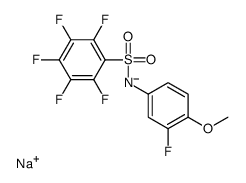Batabulin sodium
Modify Date: 2025-09-26 02:57:56

Batabulin sodium structure
|
Common Name | Batabulin sodium | ||
|---|---|---|---|---|
| CAS Number | 195533-98-3 | Molecular Weight | 393.23700 | |
| Density | N/A | Boiling Point | 403.3ºC at 760 mmHg | |
| Molecular Formula | C13H6F6NNaO3S | Melting Point | N/A | |
| MSDS | N/A | Flash Point | 197.7ºC | |
Use of Batabulin sodiumBatabulin sodium (T138067 sodium) is an antitumor agent, which binds covalently and selectively to a subset of the β-tubulin isotypes, thereby disrupting microtubule polymerization. Batabulin sodium affects cell morphology and leads to cell-cycle arrest ultimately induce apoptotic cell death. Batabulin sodium has efficacy against multidrug-resistant (MDR) tumors[1]. |
| Name | sodium,(3-fluoro-4-methoxyphenyl)-(2,3,4,5,6-pentafluorophenyl)sulfonylazanide |
|---|---|
| Synonym | More Synonyms |
| Description | Batabulin sodium (T138067 sodium) is an antitumor agent, which binds covalently and selectively to a subset of the β-tubulin isotypes, thereby disrupting microtubule polymerization. Batabulin sodium affects cell morphology and leads to cell-cycle arrest ultimately induce apoptotic cell death. Batabulin sodium has efficacy against multidrug-resistant (MDR) tumors[1]. |
|---|---|
| Related Catalog | |
| Target |
β-tubulin[1] |
| In Vitro | Batabulin (T138067; 30-300 nM; 24 hours; MCF7 cells) treatment shows approximately 25-30% tetraploid (4n) DNA content in cells, indicating an arrest at the G2/M cell-cycle boundary[1]. Batabulin (T138067; 30-300 nM; 24-48 hours; MCF7 cells) treatment shows 25-30% apoptosis. After a 48-hr exposure to 100 nM Batabulin, approximately 50-80% of the cell population is undergoing apoptosis[1]. Batabulin (T138067) binds covalently and selectively to a subset of the β-tubulin isotypes, thereby disrupting microtubule polymerization. Covalent modification occurs at a conserved Cys-239 shared by the β1, β2, and β4 tubulin isotypes. Cells exposed to Batabulin become altered in shape, indicating a collapse of the cytoskeleton, and show an increase in chromosomal ploidy[1]. Cell Cycle Analysis[1] Cell Line: MCF7 cells Concentration: 30 nM, 100 nM and 300 nM Incubation Time: 24 hours Result: Showed an arrest at the G2/M cell-cycle boundary. Apoptosis Analysis[1] Cell Line: MCF7 cells Concentration: 30 nM, 100 nM and 300 nM Incubation Time: 24 hours or 48 hours Result: 25-30% of cells showed the reduced DNA content characteristic of apoptotic cells. |
| In Vivo | Batabulin (T138067; 40 mg/kg; intraperitoneal injection; once per week; on days 5, 12, and 19; male athymic nude mice) treatment impairs the growth of the drug-sensitive CCRF-CEM tumors[1]. Animal Model: Male athymic nude mice (nu/nu) (6-8 week-old, 20-25 g) injected withCCRF-CEM cells[1] Dosage: 40 mg/kg Administration: Intraperitoneal injection; once per week; on days 5, 12, and 19 Result: Impaired the growth of the drug-sensitive CCRF-CEM tumors. |
| References |
| Boiling Point | 403.3ºC at 760 mmHg |
|---|---|
| Molecular Formula | C13H6F6NNaO3S |
| Molecular Weight | 393.23700 |
| Flash Point | 197.7ºC |
| Exact Mass | 392.98700 |
| PSA | 51.75000 |
| LogP | 5.00470 |
| Vapour Pressure | 1.03E-06mmHg at 25°C |
| Batabulin sodium |
| sodium(3-fluoro-4-methoxyphenyl)[(pentafluorophenyl)sulfonyl]azanide |
| Batabulin sodium (USAN) |